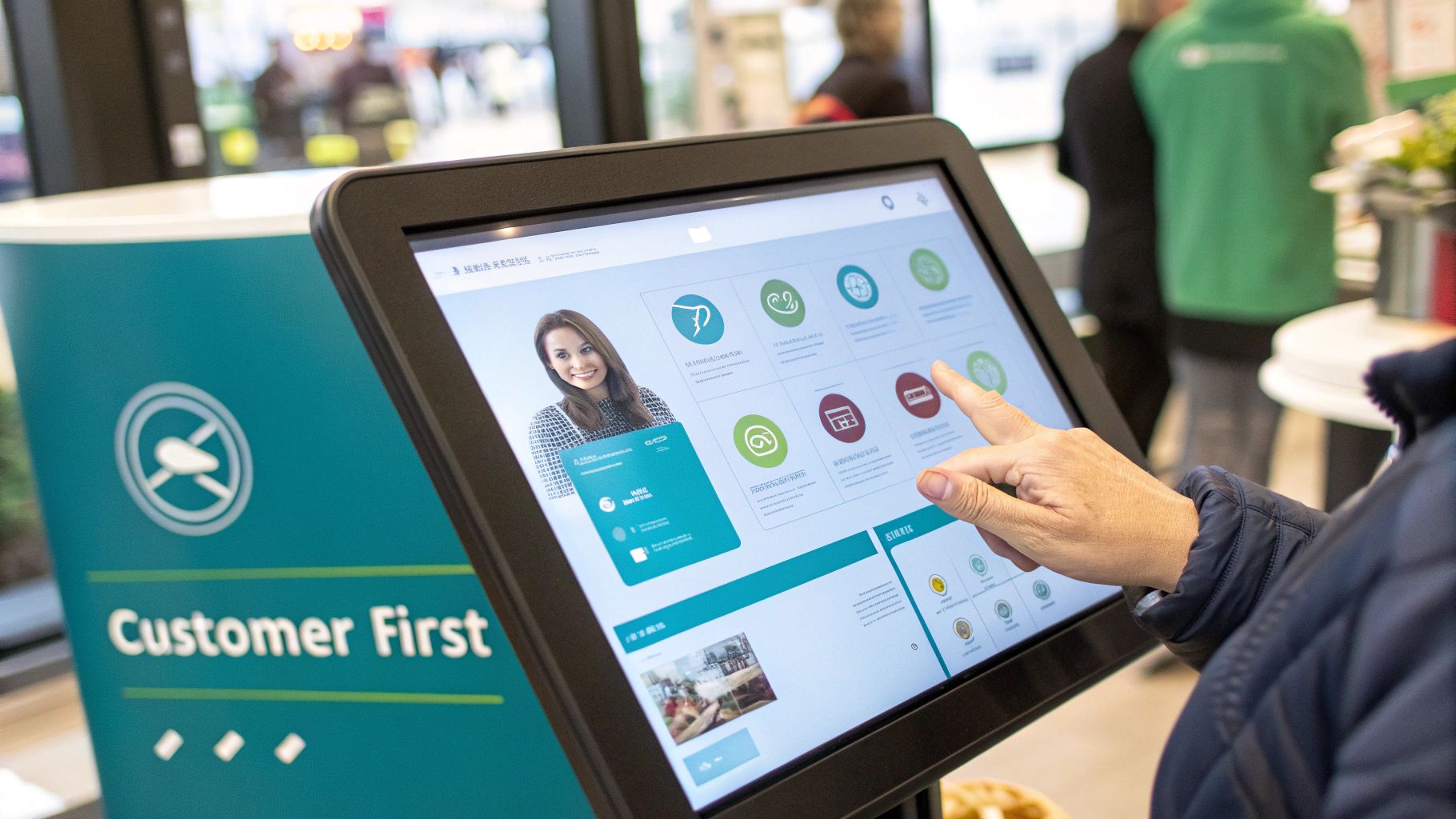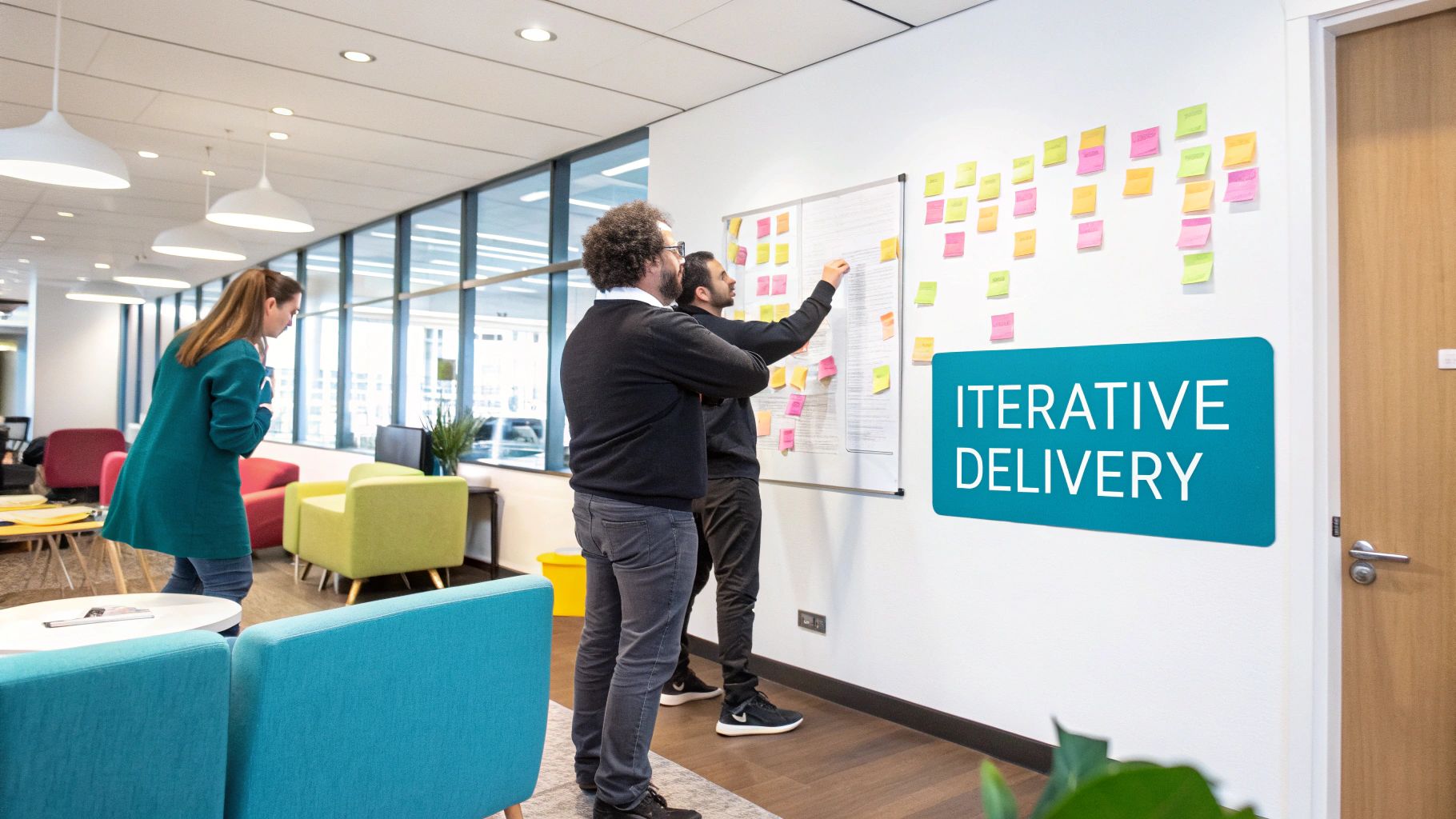In a business climate where 'disrupt or be disrupted' is the new mantra, digital transformation is no longer a strategic option. It's a fundamental requirement for survival and growth. For Small and Medium-sized Enterprises (SMEs) and ambitious startups, navigating this complex landscape can feel daunting. The process is far more than simply adopting new technology; it demands a profound shift in culture, strategy, and operations, all aimed at delivering unprecedented value to customers. The primary challenge lies in moving beyond buzzwords to implement concrete, effective strategies that yield tangible results.
This article cuts through the noise to provide a detailed roadmap. We will explore nine critical digital transformation best practices, offering actionable insights, process frameworks, and real-world examples. These are specifically tailored to help you build a resilient, future-ready organization. From securing C-suite leadership to fostering a data-driven culture and implementing a cloud-first infrastructure, each point is designed to be a practical building block for your evolution.
You will learn how to:
- Adopt an agile, iterative approach to development.
- Prioritize cybersecurity and manage digital risk effectively.
- Empower your workforce through targeted upskilling and robust change management.
- Design experiences with a relentless customer-centric focus.
By understanding and applying these core principles, you can turn the immense pressure of market disruption into your greatest competitive advantage. This guide provides the clear, actionable steps needed to not just participate in the digital future, but to lead it. Let’s dive into the essential practices that will define your success.
1. CEO and C-Suite Leadership Commitment
One of the most critical digital transformation best practices isn't a piece of technology; it's the unwavering, visible commitment from the CEO and the entire C-suite. A successful transformation is not an IT project delegated to a single department. It is a fundamental, top-down overhaul of business strategy, culture, and operations. Without executive leadership actively championing the change, initiatives often stall due to internal resistance, resource scarcity, and a lack of clear direction.

This commitment goes beyond mere approval. It involves the CEO personally articulating the "why" behind the transformation, connecting it directly to the company's future survival and growth. Leaders must model the desired digital-first behaviors and mindset, demonstrating a willingness to challenge long-standing traditions and embrace new ways of working. This active sponsorship is the engine that powers the entire initiative forward.
Real-World Example: Microsoft
Under Satya Nadella, Microsoft shifted from a Windows-centric model to a "cloud-first, mobile-first" powerhouse. Nadella didn't just authorize the change; he spearheaded it. He restructured the company, championed a culture of empathy and learning, and made massive investments in Azure, transforming Microsoft into a leader in cloud computing. This is a prime example of how C-suite vision directly translates into market dominance.
Actionable Implementation Tips
- Communicate Relentlessly: Constantly reinforce the vision and benefits of the transformation in company-wide meetings, emails, and internal communications.
- Allocate Real Resources: Back the vision with a dedicated budget and the best talent. JPMorgan Chase, for example, invests over $12 billion annually in technology, a commitment driven by CEO Jamie Dimon.
- Establish a Transformation Office: Create a cross-functional committee led by a C-suite executive to govern the initiative, track progress, and remove roadblocks. This ensures accountability.
- Invest in Leadership Literacy: Ensure the entire leadership team understands key digital concepts. This prevents a disconnect between the vision and the execution. Developing a comprehensive digital transformation roadmap is a key step where leadership's informed input is crucial. Learn more about crafting a digital transformation roadmap on creavoid.com.
2. Customer-Centric Approach and Experience Design
True digital transformation is not merely about internal process optimization; it is fundamentally about delivering superior value to the customer. Adopting a customer-centric approach means placing the end-user at the heart of every decision, from product design to operational workflow. This practice involves deeply understanding customer needs, pain points, and digital behaviors, and then re-engineering the business to create seamless, intuitive, and highly satisfying experiences across all touchpoints.

This philosophy, championed by leaders like Jeff Bezos at Amazon, shifts the focus from "what can we sell?" to "what does our customer need?". By prioritizing the customer experience, companies can build loyalty, increase retention, and create powerful brand advocates. It requires using data-driven insights not just for marketing, but for a continuous cycle of improvement, ensuring the digital solutions you build are the ones your customers actually want and will use.
Real-World Example: Sephora
Sephora excels at using technology to enhance the customer journey. Its mobile app integrates a powerful loyalty program with features like the Virtual Artist, which uses augmented reality to let customers "try on" makeup. This digital tool doesn't just sell products; it solves a real customer problem: the uncertainty of buying cosmetics online. By blending the digital and in-store experience so effectively, Sephora has created a highly personalized and engaging ecosystem that keeps customers coming back.
Actionable Implementation Tips
- Map the Customer Journey: Conduct workshops to visually map out every interaction a customer has with your brand. This reveals pain points and opportunities for digital enhancement.
- Implement Continuous Feedback Loops: Use tools like surveys, user testing sessions, and social media listening to constantly gather customer input and integrate it into your development cycle.
- Use A/B Testing for Optimization: Don't guess what works best. Systematically test variations of your website, app features, and digital communications to make data-driven decisions that improve the user experience.
- Invest in a Customer Data Platform (CDP): A CDP unifies customer data from all sources into a single, coherent profile. This 360-degree view is essential for delivering the personalized experiences modern consumers expect.
3. Data-Driven Decision Making and Analytics
Transitioning from intuition-based choices to data-driven decision making is a cornerstone of modern digital transformation best practices. This shift involves more than just collecting data; it's about building a robust infrastructure to process it, implementing advanced analytics tools, and fostering a culture where evidence and insights guide strategic direction. In a digital economy, companies that harness their data effectively can anticipate market shifts, understand customer behavior, and optimize operations with unprecedented precision.

This approach embeds analytics, artificial intelligence (AI), and machine learning (ML) into the core of the business. Instead of relying on gut feelings or historical anecdotes, leaders use predictive models and real-time dashboards to make informed, strategic moves. This data-centric mindset empowers teams at every level to test hypotheses, measure outcomes, and continuously iterate, creating a powerful engine for innovation and competitive advantage.
Real-World Example: Netflix
Netflix is a masterclass in data-driven strategy. The streaming giant meticulously analyzes viewing data, including what users watch, when they pause, and what they search for, to make critical content decisions. This analytical rigor informed the creation of hit series like "House of Cards," which was greenlit based on data showing a crossover audience for director David Fincher, actor Kevin Spacey, and the original British version of the show. This practice minimizes risk and maximizes return on content investment.
Actionable Implementation Tips
- Start with Business Questions: Don't collect data for its own sake. Define clear business questions and key performance indicators (KPIs) you want to address, such as "What is our customer churn rate?" or "Which marketing channel has the highest ROI?"
- Invest in Data Quality and Governance: Ensure your data is accurate, consistent, and secure. A successful analytics program is built on a foundation of trustworthy data, so establishing clear governance policies from the start is crucial.
- Democratize Data with Tools and Training: Equip business users, not just data scientists, with user-friendly analytics and visualization tools like Tableau or Power BI. Provide training to help them interpret data and derive actionable insights for their specific roles.
- Create Cross-Functional Data Teams: Assemble teams with a mix of data analysts, business domain experts, and IT professionals. This collaboration ensures that the insights generated are not only statistically sound but also relevant and applicable to real-world business challenges.
4. Agile and Iterative Development Methodology
A core tenet of modern digital transformation best practices involves abandoning rigid, slow-moving project management in favor of agility. Adopting an agile and iterative development methodology allows organizations to be more responsive, flexible, and customer-centric. Instead of long, linear "waterfall" cycles, agile breaks down large projects into small, manageable increments called sprints. This enables continuous improvement, rapid feedback loops, and the ability to pivot quickly based on market changes or user data.

This approach is not just for software development; it's a business mindset. It fosters collaboration between self-organizing, cross-functional teams and prioritizes delivering tangible value to the customer at regular intervals. By building, measuring, and learning in rapid cycles, companies can reduce risk, accelerate time-to-market, and ensure the final product truly meets user needs, which is a cornerstone of a successful digital transformation.
Real-World Example: Spotify
Spotify is famous for its "squad" model, an at-scale implementation of agile principles. The company organizes its teams into small, autonomous units (squads) that own specific features from end to end. This structure promotes ownership, speeds up decision-making, and has allowed Spotify to continuously innovate and deploy new features, keeping it ahead in the competitive music streaming industry. This organizational design is a powerful demonstration of how agile philosophy can shape an entire company's culture and operational effectiveness.
Actionable Implementation Tips
- Start with a Pilot: Don't try to transform the entire organization overnight. Select a single, high-impact project to pilot the agile methodology, learn from the experience, and then scale gradually.
- Invest in Training and Coaching: Agile requires a significant mindset shift. Provide formal training on frameworks like Scrum or Kanban and consider hiring an agile coach to guide teams through the initial transition.
- Form Cross-Functional Teams: Break down departmental silos. Create teams with all the skills needed (e.g., design, development, marketing, QA) to complete a project increment independently.
- Establish a Clear "Definition of Done": To ensure quality and alignment, every team must agree on a specific set of criteria that a task must meet before it can be considered complete. This prevents ambiguity and rework.
5. Employee Upskilling and Change Management
Technology is only one part of the digital equation; the human element is equally, if not more, critical. A core digital transformation best practice is to proactively invest in employee upskilling and manage the cultural shift that accompanies new processes. Simply deploying new software without preparing your team is a recipe for low adoption, frustration, and failure. Effective transformation requires building the digital capabilities and mindsets of the people who will use the new tools and systems every day.
This means moving beyond one-off training sessions to create a continuous learning culture. It involves a strategic approach to identifying future skill needs, providing accessible and relevant training, and managing the human side of change with empathy and clear communication. Supporting employees through this transition ensures they feel valued and empowered rather than threatened by new technology.
Real-World Example: Amazon
Amazon's "Career Choice" program is a powerful example of upskilling at scale. The company pre-pays 95% of tuition for employees to take courses in high-demand fields, even if those fields are not directly related to their current roles at Amazon. By investing heavily in its workforce's future skills, Amazon not only facilitates its own digital evolution but also fosters immense employee loyalty and prepares its team for the economy of tomorrow.
Actionable Implementation Tips
- Conduct a Skill Gap Analysis: Before launching any training, assess your team's current digital literacy and identify the specific skills needed to support your transformation goals. This ensures your investment is targeted and effective.
- Offer Diverse Learning Formats: Cater to different learning styles by providing a mix of online courses, hands-on workshops, peer mentoring, and self-paced modules.
- Appoint Digital Champions: Identify and empower enthusiastic employees to act as internal advocates. These champions can provide peer support, share success stories, and help drive adoption from the ground up.
- Link Training to Career Growth: Clearly demonstrate how acquiring new digital skills can lead to promotions, new responsibilities, and career advancement. This provides a powerful incentive for employees to engage with training initiatives.
6. Cloud-First Infrastructure and Architecture
A foundational digital transformation best practice is the strategic adoption of a cloud-first infrastructure. This approach prioritizes cloud computing for all new technology deployments and gradually migrates existing on-premise systems. It is not just about moving servers to a data center; it's a fundamental shift in how businesses procure, manage, and leverage technology to gain agility, scalability, and a competitive edge. By treating cloud as the default choice, companies unlock the ability to innovate faster and respond to market changes with unprecedented speed.
Embracing a cloud-first architecture means moving away from rigid, capital-intensive hardware cycles. Instead, businesses can access virtually limitless computing power on a flexible, pay-as-you-go basis. This allows for rapid experimentation, cost-effective scaling during peak demand, and access to advanced services like AI and machine learning without massive upfront investment. It transforms IT from a cost center into a strategic enabler of business growth and innovation.
Real-World Example: Netflix
Netflix is a quintessential example of a successful cloud-first strategy. Early in its streaming journey, the company made the bold decision to migrate its entire infrastructure from its own data centers to Amazon Web Services (AWS). This move gave Netflix the massive scalability needed to support its global expansion and the flexibility to continuously deploy new features. Its cloud-native architecture is a key reason it can handle immense traffic and maintain a high-quality user experience worldwide.
Actionable Implementation Tips
- Start with Non-Critical Applications: Begin your cloud journey by migrating less complex, non-critical workloads. This helps your team build skills and confidence while minimizing risk.
- Invest in Cloud Security and Governance: Proactively implement robust security protocols and governance frameworks specifically for the cloud. This includes identity management, data encryption, and compliance monitoring.
- Train Teams on Cloud-Native Development: Equip your developers with the skills to build applications designed for the cloud (e.g., using microservices and containers). This maximizes the benefits of cloud infrastructure.
- Monitor and Optimize Cloud Costs: Regularly use cloud cost management tools to analyze spending and eliminate waste. Without careful oversight, cloud bills can quickly escalate. Learn more about choosing the right cloud platforms and solutions on creavoid.com.
7. API-First and Microservices Architecture
Another foundational digital transformation best practice involves a shift in how you build and structure your technology. Adopting an API-first approach and a microservices architecture moves you away from rigid, monolithic systems. Instead, you design systems with Application Programming Interfaces (APIs) as the primary interface and break down large applications into smaller, independently deployable services. This architectural choice is crucial for building resilient, scalable, and adaptable digital platforms.
This modern approach enables faster development cycles, as teams can work on different microservices simultaneously without disrupting the entire system. It also allows for easier integration with third-party tools and fosters innovation by making data and functionality accessible through well-defined APIs. Ultimately, it creates a flexible technology backbone that can evolve with your business needs, rather than constraining them.
Real-World Example: Netflix
Netflix's transition from a monolithic DVD rental service to a global streaming giant is a textbook case of leveraging microservices. Faced with scaling challenges, Netflix re-architected its entire platform into hundreds of fine-grained microservices, each handling a specific function like user authentication, billing, or video streaming. This allowed them to innovate rapidly, maintain high availability, and scale to serve millions of concurrent users, a feat impossible with their old architecture.
Actionable Implementation Tips
- Start with Domain-Driven Design (DDD): Organize your services around business capabilities, not technical layers. This ensures your architecture directly supports and reflects business processes.
- Implement Comprehensive API Documentation: Use standards like OpenAPI (Swagger) to create clear, interactive documentation. This is essential for both internal developers and external partners who will consume your APIs.
- Use Containerization: Deploy services using technologies like Docker and orchestrate them with Kubernetes. Containers make your microservices portable and simplify deployment, scaling, and management across different environments.
- Invest in an API Gateway: An API gateway acts as a single entry point for all clients, handling tasks like routing, security, and rate limiting. This simplifies the client-side and secures your backend services.
8. Cybersecurity and Digital Risk Management
As businesses digitize their operations, they inherently expand their attack surface, making robust cybersecurity a non-negotiable component of any transformation strategy. This digital transformation best practice involves embedding security into every facet of the initiative, rather than treating it as an afterthought. It means shifting from a traditional perimeter-based defense to a more dynamic, proactive approach that protects digital assets, sensitive customer data, and core business functions from an evolving threat landscape.
This proactive stance requires implementing comprehensive security measures from the ground up. Adopting frameworks like zero-trust security, which assumes no user or device is inherently trustworthy, is crucial. This model enforces strict verification for every person and device trying to access resources on the network, significantly reducing the risk of unauthorized access and lateral movement by attackers.
Real-World Example: Maersk
The 2017 NotPetya cyberattack on global shipping giant Maersk serves as a powerful lesson. The attack crippled their entire global IT infrastructure in hours, costing the company an estimated $300 million. Their recovery, however, demonstrated resilience built from a renewed focus on cybersecurity. They rebuilt their entire network with security-by-design principles, segmenting systems and implementing stronger access controls, transforming a catastrophic event into a catalyst for a more secure and resilient digital foundation.
Actionable Implementation Tips
- Implement Security by Design: Embed security controls and reviews into the earliest stages of any new project or system development lifecycle, not just before launch.
- Conduct Regular Security Audits: Proactively identify vulnerabilities by performing regular penetration testing and security assessments on your critical systems and applications.
- Train Your Entire Team: The human element is often the weakest link. Provide continuous security awareness training to all employees to help them recognize phishing attempts and follow best practices.
- Establish a Clear Incident Response Plan: Develop, document, and practice a detailed plan for how your organization will respond to a security breach to minimize damage and ensure business continuity. Explore more about cybersecurity and data protection on creavoid.com.
9. Strategic Partnerships and Ecosystem Building
Digital transformation is not a solo journey. One of the most powerful digital transformation best practices is to look beyond your organization's walls and build a robust ecosystem of strategic partnerships. This means collaborating with technology providers, innovative startups, and even competitors to access new capabilities, accelerate innovation, and create shared value. Instead of trying to build every new technology or skill internally, smart companies leverage external expertise to move faster and more efficiently.
This approach transforms the traditional, linear value chain into a dynamic, interconnected network. By forming alliances, you can tap into specialized knowledge, co-develop new products, and gain access to new markets or customer segments. These partnerships act as accelerators, allowing you to integrate cutting-edge solutions, from cloud infrastructure to AI algorithms, without the time and expense of developing them from scratch.
Real-World Example: Ford & Google
Ford's alliance with Google is a prime example of ecosystem building in action. Rather than attempting to create a competing infotainment and connectivity platform, Ford partnered with Google to integrate Android Automotive OS directly into millions of its vehicles. This gives Ford access to Google's best-in-class apps like Google Maps and Google Assistant, while allowing Ford to focus on its core competency: building vehicles. The partnership accelerates Ford's connected car strategy and improves the customer experience instantly.
Actionable Implementation Tips
- Define Clear Partnership Goals: Before seeking partners, clearly articulate what you want to achieve. Is it access to technology, a new market, or a specific customer base? Success metrics must be defined upfront.
- Establish Strong Governance: Create a clear framework for managing the partnership, including roles, responsibilities, communication protocols, and decision-making processes. This prevents misunderstandings and keeps the collaboration on track.
- Create Win-Win Value Propositions: A successful partnership must benefit all parties. Ensure your proposal clearly outlines the value your partner will receive, whether it's revenue, data insights, or access to your customer base.
- Conduct Thorough Due Diligence: Vet potential partners carefully. Assess their technological capabilities, financial stability, and, most importantly, their cultural fit with your organization to ensure a smooth collaboration.
Digital Transformation Best Practices Comparison
| Initiative | Implementation Complexity | Resource Requirements | Expected Outcomes | Ideal Use Cases | Key Advantages |
|---|---|---|---|---|---|
| CEO and C-Suite Leadership Commitment | Moderate to High | High (leadership time, budget) | Strong alignment, faster decisions, cultural change | Large-scale transformations needing strategic direction | Ensures buy-in, accountability, resource allocation |
| Customer-Centric Approach and Experience Design | High | High (tech, talent investment) | Increased satisfaction, loyalty, competitive edge | Customer-focused digital product/service redesigns | Enhances customer loyalty and revenue growth |
| Data-Driven Decision Making and Analytics | High | High (data infrastructure, skills) | Better decisions, predictive insights, efficiency | Data-intensive operations, innovation through analytics | Increases accuracy, opportunity identification |
| Agile and Iterative Development Methodology | Moderate | Moderate (training, tools) | Faster delivery, adaptability, continuous value | Software development, projects needing flexibility | Accelerates time-to-market, improves team collaboration |
| Employee Upskilling and Change Management | Moderate | High (training programs, time) | Reduced resistance, improved skills, faster adoption | Organizations undergoing cultural/skill transformations | Builds capabilities, enhances engagement |
| Cloud-First Infrastructure and Architecture | High | High (cloud migration, expertise) | Scalability, cost savings, agility | IT infrastructure modernization and scalability | Reduces costs, improves flexibility and innovation |
| API-First and Microservices Architecture | High | High (development, monitoring) | Scalability, resilience, faster deployment | Complex systems requiring modularity and integration | Enables faster releases, system flexibility |
| Cybersecurity and Digital Risk Management | High | High (security tools, expertise) | Protection from threats, compliance, trust | All digital operations, especially regulated industries | Safeguards assets, ensures compliance |
| Strategic Partnerships and Ecosystem Building | Moderate | Moderate to High (partner management) | Accelerated innovation, risk-sharing, market expansion | Companies leveraging external innovation and networks | Access to expertise, faster innovation cycles |
Your Next Move: Activating Your Transformation Journey
Embarking on a digital transformation journey is a marathon, not a sprint. The nine best practices outlined in this guide are not independent items on a checklist; they are deeply interconnected pillars that form the foundation of a holistic, successful strategy. From securing unwavering C-suite leadership to fostering a robust ecosystem of strategic partners, each element reinforces the others, creating a powerful synergy that drives meaningful change.
Success hinges on weaving these principles into the very fabric of your organization's culture, processes, and technology stack. It requires a fundamental shift towards a customer-obsessed mindset, where every decision is validated against the value it delivers to the end-user. It demands a culture of data-driven agility, replacing gut feelings with empirical evidence and embracing iterative development to adapt to market shifts with speed and precision.
Synthesizing the Core Pillars
Let's distill the journey into its most critical components. True transformation is built upon three core areas of focus:
- Leadership and People: It all starts at the top. Without committed leadership championing the vision and a proactive change management strategy to upskill and empower your employees, even the most brilliant technology will fail to gain traction. Your people are not just part of the transformation; they are the engine that powers it.
- Process and Agility: Moving from rigid, siloed operations to a dynamic, agile methodology is non-negotiable. This process-level change, supported by a data-first approach, allows your organization to learn, pivot, and innovate faster than the competition. It's about building a system that thrives on feedback and continuous improvement.
- Technology and Architecture: Your technology choices must enable, not hinder, this new way of working. A cloud-first infrastructure, an API-first architecture, and a vigilant approach to cybersecurity are the technical cornerstones. This modern stack provides the scalability, flexibility, and security needed to build exceptional customer experiences and operate efficiently.
From Theory to Action: Your Immediate Next Steps
Reading about digital transformation best practices is the first step, but action is what creates momentum. The path forward can feel overwhelming, especially for resource-conscious SMEs and startups. The key is to start small, build momentum, and scale your successes.
Here is a practical, three-step plan to activate your journey today:
- Conduct a Self-Assessment: Use the nine practices in this article as a scorecard. Honestly evaluate where your organization currently stands on each one. Where are your most significant gaps? Where do you have surprising strengths? This initial audit will provide a clear, data-informed starting point.
- Identify Your "Keystone" Initiative: You cannot tackle everything at once. Based on your assessment, choose one or two high-impact areas for immediate focus. Perhaps it’s establishing a formal data analytics workflow or migrating a single, critical application to the cloud. A "keystone" win builds confidence and secures buy-in for future initiatives.
- Create a Cross-Functional "Tiger Team": Assemble a small, dedicated team of passionate individuals from different departments (e.g., marketing, operations, tech). Empower this team to own your first initiative. This cross-functional approach breaks down silos and ensures the solution addresses a genuine, organization-wide need.
While the path is complex, the rewards are truly transformative: unparalleled operational efficiency, deeply loyal customers, and a sustainable competitive advantage in an increasingly digital world. Mastering these digital transformation best practices is not just about updating technology; it's about future-proofing your entire business.
Ready to translate these best practices into tangible results? The expert team at creavoid specializes in building the AI-powered automations and scalable SaaS platforms that accelerate your transformation. Partner with us to turn your strategic vision into a market-leading reality. Learn more at creavoid.




